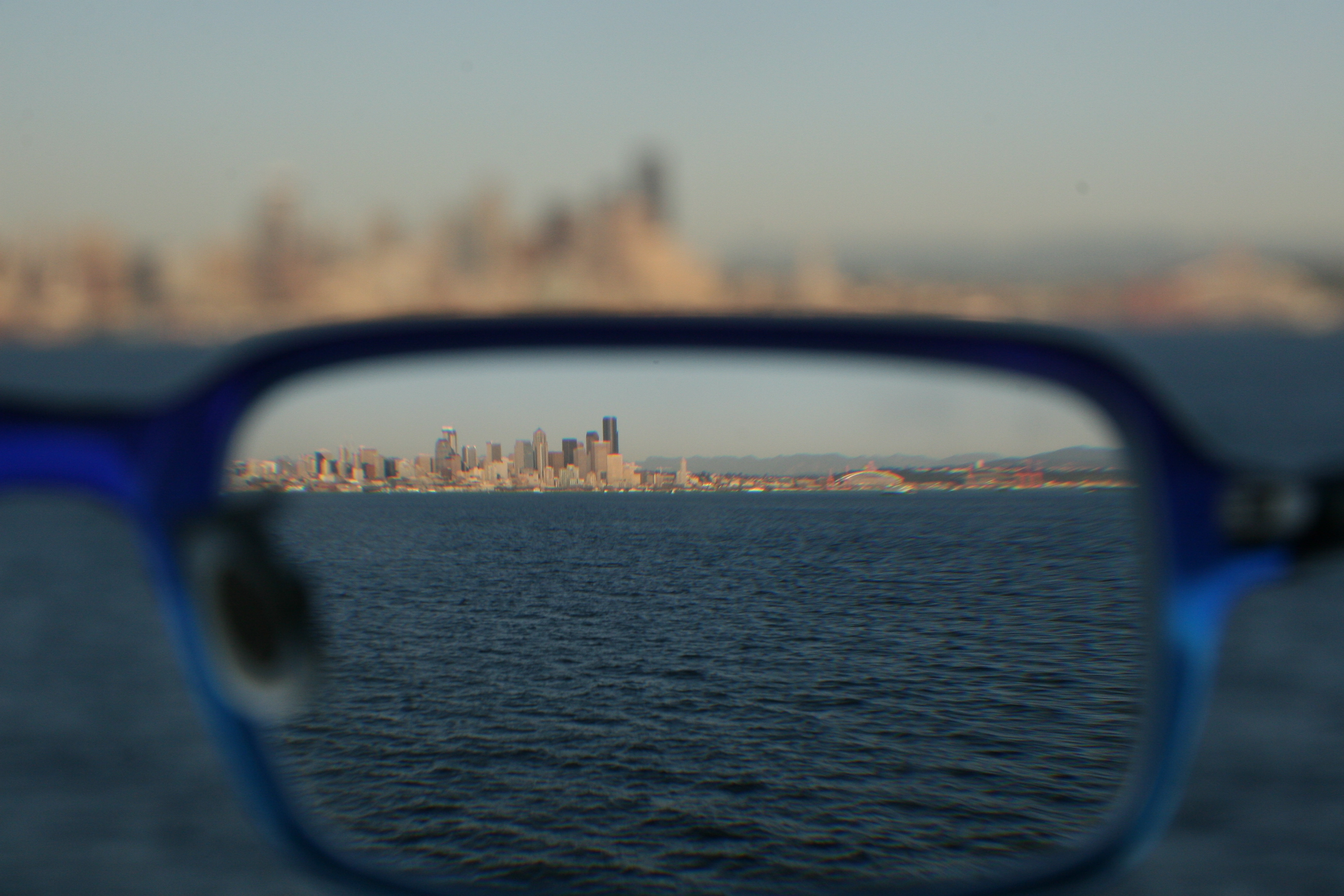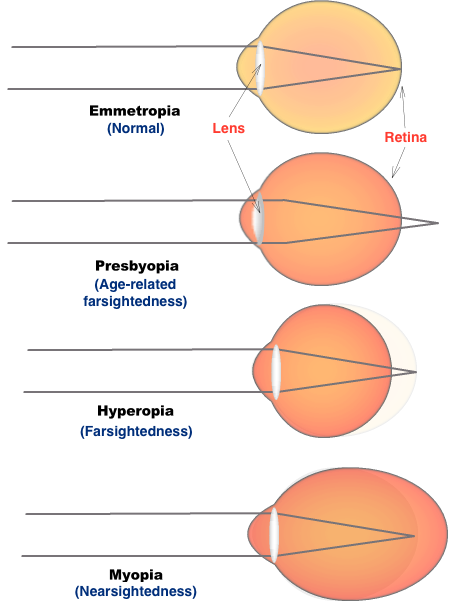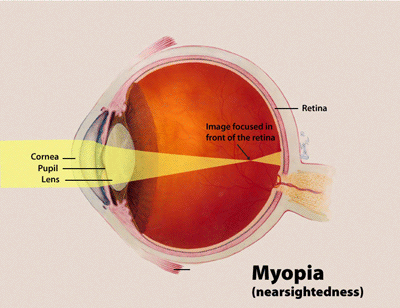 Many of us begin our day by putting on glasses or inserting contacts to see better. This includes myself. Without this simple step we wouldn’t be able to recognize much, let alone function adequately at our job or school due to poor vision.
Many of us begin our day by putting on glasses or inserting contacts to see better. This includes myself. Without this simple step we wouldn’t be able to recognize much, let alone function adequately at our job or school due to poor vision.
For two billion people across the globe this is due to a condition called myopia.1 There are several options to treat myopia including glasses, contacts, and surgery.
Lasik has become quite popular as the surgical method of choice. Lasik involves permanently changing the shape of the cornea through a surgical procedure to allow for clear vision. As with any surgery it involves potential risks such as chronic dry eye, glare, halos, night vision problems, and possible infection. It’s also not typically permanent for most patients, and surgery will have to be repeated at some point in the future or corrective lenses will need to be used as an alternative. In spite of all this, Lasik surgery remains a viable option for many people.
For individuals who wish to avoid surgery there is another alternative called Corneal Refractive Therapy (CRT). I’ll introduce this topic after first explaining what myopia is and what puts people at risk for myopia.

What is Myopia?
Myopia is also known as nearsightedness. This results in blurry vision when looking at far away objects and clear vision when looking at up-close objects.
Myopia occurs due to the eyeball growing too long. As a result, the eye will focus images in front of the retina instead of on the retina. This leads to blurry vision when looking at far-away objects.
You can see the difference in eyeball sizes and the various eye conditions in the picture to the right. Emmetropia is a normal eye providing normal vision. Presbyopia and hyperopia are two different forms of farsightedness. Myopia is an elongated eye leading to nearsightedness.
What Causes Myopia?
Myopia affects approximately one-third of the U.S. population and 50%-70% of Asian populations, with up to 90% of individuals in East Asian countries.2,3 While no single one cause has been identified for the development of myopia, both genetic and environmental factors have been shown to play a role.
Of these factors, family history and time spent outdoors seems to have a significant impact on the potential development of myopia. In the past, it was also thought that individuals who engage in more near work (i.e. reading) may have a higher risk of developing myopia. However, there is little to no evidence of this happening according to the scientific literature.4
Genetic Influences on Myopia
One study analyzing genetic inheritance of myopia between parents and 7-year-old children found that 7.3% of children became myopic when neither parent was myopic, 26.2% when one parent was myopic, and 45% when both parents were myopic.5
If either one or both of your parents are myopic then there is a higher chance that you will be too.
Outdoor Time and Myopia
As mentioned before, spending time outdoors during childhood also effects the incidence of myopia. A meta-analysis looking at time spent outdoors by children and adolescents found a 2% reduction in odds of developing myopia for every one additional hour of time spent outdoors per week.6
Another study showed that for those children with two myopic parents, the odds of myopia reduced from 60% to 20% in those spending more than 14 hours per week outdoors.7
As a parent, you should encourage your child to go outdoors and play everyday. It has benefits both in reducing myopia and in keeping kids lean and healthy.
Diet’s Role on Myopia
In terms of nutrition’s role on the development of myopia, very few studies have been done to establish a consensus on exactly what, if any, diet has on this condition. The few studies looking at this have mostly been observational in nature, meaning, at best, they can only show a correlation between diet and myopia and do not prove a direct cause and effect relationship.
Back in the 1960’s a research fellow in ophthalmology named P.A. Gardiner looked at protein intake on myopia. He gathered data on a little over 100 myopic children between the ages of 7 and 16 years of age.8 He found a correlation between an increase in myopia and low and high intakes of animal protein. Children consuming less than 7% or more than 11% of calories from animal protein had higher rates of myopia.
Gardiner also observed vegetable protein intake in these children. He found that myopia decreased with more vegetable protein intake. When looking at a ratio of animal versus vegetable protein intake, he found that myopia incidence increased when the ratio of animal versus vegetable protein reached 3 or higher, meaning those children consuming more animal protein compared to plant protein had higher risks of developing myopia.
As you can see, there are things a person can do to decrease their risk of myopia during childhood (but not adulthood). While you can’t control your genetic makeup, you can encourage your children to play outside more. This is a proven way to decrease myopia risk. Eating healthier, including eating more vegetables in place of animal protein, may also play a beneficial role, although very scant evidence exists to suggest any official dietary recommendations to prevent this eye condition.
What Are the Long-Term Risks of Myopia?
For those of us who already have myopia there are some long-term risks we need to be aware of. These include cataracts, glaucoma, macular degeneration, retinal detachment, retinal breaks, chorioretinal atrophy, lacquer cracks, and other eye complications.1,9 These conditions will typically develop later in life if they develop at all, and if not treated appropriately may lead to blindness.
 Unfortunately, once we’ve reached adulthood there is nothing we can do to reverse myopia and/or reduce the risk of these long-term effects. This is why it’s so important to screen for myopia in our children to prevent them from developing this condition and the long-term adverse effects associated with it.
Unfortunately, once we’ve reached adulthood there is nothing we can do to reverse myopia and/or reduce the risk of these long-term effects. This is why it’s so important to screen for myopia in our children to prevent them from developing this condition and the long-term adverse effects associated with it.
Most cases of myopia typically start to develop in children at 8 years of age and progress until ages 15 or 16.2 Having your child screened during early childhood on an annual basis can catch myopia in the beginning stages. This allows for preventative treatment to be implicated to inhibit myopia from progressing into an irreversible form in adulthood. This obviously will avoid a lot of pain and suffering throughout life and later on for these children.
While there is no one treatment option that is 100% proven to prevent myopia progression in children there are a few choices to choose from. Topical pharmaceutical agents such as atropine and pirenzepine drops have been used, although the side effects and lack of efficacy limit their appeal.2 Soft bifocal contact lenses worn during the day have been shown to reduce the progression of myopia by 50% in children. In addition, Corneal Refractive Therapy can be used.
What is Corneal Refractive Therapy (CRT)?
Corneal Refractive Therapy is a form of therapy used to prevent myopia progression in children and treat myopia in adults. It is also called orthokeratology or Ortho-K.
CRT involves inserting a pair of rigid gas permeable contact lenses (i.e. hard contact lenses) at bedtime and sleeping with them in and then removing these lenses upon awakening. The lenses will temporarily change the shape of the cornea to allow for clear vision during the day without the need for contacts or glasses.
CRT lenses need to be worn for 6-8 hours at night. It takes approximately three to fourteen nights, initially, to achieve clear vision throughout the day, but eventually patients can get up to 24-72 hours of clear daytime vision.
CRT lenses have been shown in a meta-analysis to decrease myopic progression in children by approximately 45%.10 This is close to the same reduction in risk of myopic progression that soft bifocal contact lenses produce.2 However, as mentioned, CRT lenses are worn comfortably at night while asleep, and soft bifocal lenses must be worn throughout the day which may be bothersome to the patient.
To learn more about this process, watch the short video below.
What Are the Side Effects of CRT Lenses?
CRT lenses are safe to use. There are a few potential side effects to using these lenses, but they are typically no worse than using regular contact lenses during the day. In fact, many of the bothersome side effects like dry eye(s) and irritation are less so, or even nonexistent, compared to regular contact lens wear.
Rare cases of eye infections have been reported in the medical literature with CRT lenses. However, these cases were mostly in patients who had been improperly fitted by practitioners who were not properly trained.11 Infections also occurred in some patients who did not adhere to proper cleaning care of their lenses.
Corneal staining and lens binding have been reported, although this was usually in individuals with certain pre-existing eye conditions, sensitivity to contact lens solutions, or improperly fitted lenses.
Compared to Lasik surgery, these potential side effects are rare and minor in nature. With properly fitted lenses and staying compliant with appropriate cleaning instructions and use of CRT lenses, there really should be little to no adverse effects experienced by the patient.
How Much Does CRT Cost?
The initial cost of CRT lenses, including fitting and follow-up care with an eye doctor, costs anywhere from $1,000 to $2,000 depending on where you live in the U.S. This equals about half the cost of Lasik surgery.
Replacement lenses, contact lens solutions, and follow-up visits range from $300 to $500 annually. Technically, CRT lenses are supposed to be replaced every year. However, with proper care and fitting they may last up to 18 to 24 months.
Conclusion
Myopia, or nearsightedness, affects billions of people worldwide. It involves more than just blurry vision for those who suffer from it. It can also lead to an increased risk of serious eye conditions such as glaucoma, macular degeneration, retinal detachment, and cataracts. This is why it’s so important to catch it early in childhood and try to avoid the progression of it.
Soft bifocal contact lenses worn during the day or CRT lenses worn while sleeping are both viable options in preventing progression of myopia in children. CRT lenses give the added benefit of not having to wear glasses or contacts throughout the day. They can also be used in adults to treat myopia and achieve clear vision without the potential risks of undergoing a surgical procedure such as Lasik.
Every person will have to evaluate the pros and cons of what they feel is the best option for them while facing blurry vision due to myopia. CRT lenses are certainly a viable option not widely known about in the general public. This therapy is definitely worth looking into if you or your children are in need of preventative or treatment options for myopia.
My Personal Experience with CRT Lenses
I’ve had blurry vision since being a small child. My father and mother do not have myopia. They’ve always been lens free. I guess you could say I’m the oddball out.
I received my first set of glasses in the second grade. I called them my Charlie Brown glasses. This is because they had a small Charlie Brown sticker on the side of the frame. I loved them then but looking back on this they were definitely vintage and hideous taking up almost my entire face. I could see though, and that’s all that mattered.
Later during middle school it was no longer cool to wear glasses so I received my first pair of contacts. I was in heaven. No more being made fun of. No more ‘four eyes’ comments. I was “cool” again. As I got into college and beyond, wearing contacts dried out my eyes chronically. It got to the point where I couldn’t make it more than a few hours without becoming uncomfortable with dry eyes so I went back to glasses. I’ve worn glasses ever since until recently when I found out about CRT lenses.
I started wearing CRT lenses this past September. It has been great overall, but did start out a bit challenging. I’ve never worn hard contact lenses before and found them uncomfortable at first, at least when having my eyes open. Since they are not to be worn during daytime hours, I put them in immediately before going to bed and remove them immediately upon awakening. The uncomfortableness has gotten better over time, although I would still say it is not the most pleasant feeling to have them in while my eyes are open.
My optometrist predicted my CRT lenses would take effect providing clear vision approximately three to four days after starting them. It took a little longer than this as the initial fitting of the lenses had to be tweaked over a couple of follow-up visits. This was to allow for the lenses to center on my eyes better while sleeping. I asked my optometrist approximately how many patients were able to be fitted correctly the first time they tried CRT lenses. He stated about 80%-85%. I guess I was a troublemaker. I always have seemed to have defied the odds in life.
Once these initial adjustments were made my vision became clear within two to three days of wearing the newly fitted lenses. It has been wonderful to be able to see clearly without the aid of corrective lenses during the day. The CRT lenses are hardly even noticeable while my eyes are closed at night during sleep. Learning to insert and remove the lenses has taken some time to perfect, but is now not a problem.
I’m very happy overall with my choice to switch to CRT lenses and would highly recommend it to others looking for a nonsurgical alternative to Lasik with little risk, especially if traditional daytime contact lenses are bothersome to wear.
If you are in the Tampa Bay area and looking for an optometrist to get you started on CRT lenses, I would encourage you to visit Dr. William Stephen at St. Lucy’s Vision Center. He is a wonderful doctor and very knowledgable. As a disclaimer, I am not getting paid in anyway to refer patients to Dr. Stephen. I have just found that he is an excellent optometrist with superb qualifications and over 16 years of experience providing CRT therapy. His staff is very friendly and a joy to work with.
ParagonVision.com also has a search feature on their website for finding an eye care professional who offers CRT therapy if you wish to use this.

If you like what you see here, then you’ll LOVE my daily Facebook and Twitter posts! Also, don’t forget to sign up for my Free Online Mailing List to get all the latest updates from the Plant-Based Pharmacist!
Check out my book, The Empty Medicine Cabinet, to start your journey towards better health. This step-by-step guide leads you through many of today’s common chronic diseases (heart disease, obesity, diabetes, cancer, and more), giving you the facts on food versus medication in treating these medical conditions. The book also contains an easy-to-follow guide on how to adopt a whole foods, plant-based diet as a part of an overall lifestyle change, producing the best possible health outcomes for you and your family. Hurry and get your copy today!
References:
1 Holden BA, Jong M, et al. Nearly 1 billion myopes at risk of myopia-related sight-threatening conditions by 2050 – time to act now. Clin Exp Optom. 2015 Nov;98(6):491-3.
2 Smith MJ, Walline JJ. Controlling myopia progression in children and adolescents. Adolesc Health Med Ther. 2015 Aug 13;6:133-40.
3 Young TL. The Molecular Genetics of Human Myopia: An Update. Optometry and vision science : official publication of the American Academy of Optometry. 2009;86(1):E8-E22.
4 Mutti DO, Zadnik K. Has near work’s star fallen? Optom Vis Sci. 2009 Feb;86(2):76-8.
5 Yap M, Wu M, Liu ZM, Lee FL, Wang SH. Role of heredity in the genesis of myopia. Ophthalmic Physiol Opt. 1993;13:316–319.
6 Sherwin JC, Reacher MH, et al. The association between time spent outdoors and myopia in children and adolescents: a systematic review and meta-analysis. Ophthalmology. 2012 Oct;119(10):2141-51.
7 Jones LA, Sinnott LT, et al. Parental history of myopia, sports and outdoor activities, and future myopia. Invest Ophthalmol Vis Sci. 2007 Aug;48(8):3524-32.
8 Gardiner PA. Protein and myopia. Proc Nutr Soc. 1960;19:96-100.
9 Saw SM, Gazzard G, et al. Myopia and associated pathological complications. Ophthalmic Physiol Opt. 2005 Sep;25(5):381-91. Review.
10 Sun Y, Xu F, Zhang T, et al. Orthokeratology to Control Myopia Progression: A Meta-Analysis. Al-Ghoul KJ, ed. PLoS ONE. 2015;10(4):e0124535.
11 Liu YM, Xie P. The Safety of Orthokeratology—A Systematic Review. Eye & Contact Lens. 2016;42(1):35-42.


.jpg)